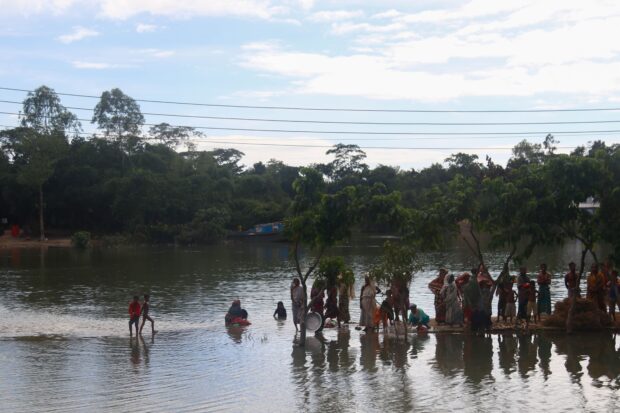Rising seas due to climate change could exacerbate the threat of arsenic in drinking water, according to a study published in PLOS One in January. Researchers focused on arsenic in well water in Bangladesh, where up to 97 percent of the population relies on such water for drinking.
Arsenic occurs naturally in the earth’s crust, but how much arsenic is present in groundwater depends on geology, fertilizer habits and land use patterns, among other factors. (Industrial activities like tanning leather release arsenic, for example.) The researchers determined that sea level rise can increase even modest levels of arsenic due to a phenomenon known as saltwater intrusion.
Seawater can ordinarily only move so far inland; the saltwater-freshwater meeting point is known as the “salt front.” When sea levels rise, though, that front can move inland as the heavier saltwater pushes the groundwater table up from below and as storm surges and high tides flood more land and send saltwater into groundwater supplies from above. Saltwater is better at dissolving certain minerals than freshwater — picture a car corroding after it’s exposed to road salt — which means even small increases in groundwater salinity can cause more arsenic to dissolve.
The PLOS ONE study focused on Bangladesh because of groundwater’s importance to the country’s drinking supply, and because flooding is already prevalent during monsoon season. “Tens of millions of people” in Bangladesh are drinking well water with arsenic concentrations above the safety threshold identified by the World Health Organization, the researchers note.
According to the WHO, arsenic is naturally present at high levels in groundwater in countries that include Bangladesh, Argentina, China and the US. That means the researchers’ conclusions “would not only happen in Bangladesh,” says Seth Frisbie, professor emeritus of chemistry and biochemistry at Norwich University and lead author of the study. Anywhere there is arsenic in sediment, “as the aquifer becomes more saline, we would expect more arsenic,” he says.
When arsenic makes its way into drinking water or food (most notably rice), it can render the water undrinkable and cause negative health impacts for those who consume it. Children and teens exposed to arsenic can experience cognitive impairments such as difficulty focusing and issues with memory, verbal comprehension and reasoning. Long-term exposure in adults is linked to cardiovascular disease, diabetes and several types of cancer. Frisbie’s research suggests that those health risks remain even if the water isn’t so salty as to be undrinkable.
“Seawater intrusion is something that coastal zones have been thinking about for a long time,” says Holly Michael, director of the Environmental Institute at the University of Delaware, noting that typically the salt itself is focused on as a contaminant. “The question of how climate change and sea level rise might affect other contaminants is flying under the radar.”
Michael noted that the study’s methodology is limited: It relies on a small data sample and focuses narrowly on saltwater, when a growing body of research suggests that contaminant issues from freshwater flooding and rising groundwater might be the bigger threat. But the release of contaminants such as arsenic “is potentially a major problem” for areas along the U.S. East Coast, she says, where sea level is rising and the remediation strategy for industrial contaminants doesn’t always account for flooding that isn’t caused by rainfall.
The risks may not only apply to arsenic, either. “There [are] 76 chemicals in the rocks of the Earth’s crust,” Frisbie says, including lead, cadmium and mercury. “Because we drink filtered mud — that’s what drinking water is — we would expect to find those 76 elements in drinking water.”
That possibility is especially concerning in places where drinking water isn’t routinely tested. In some parts of Bangladesh, for example, it took decades for people to realize the water was tainted with arsenic. In the US, roughly 43 million people rely on private wells for drinking water, and may not know they’re at risk until the water has already caused them harm.
“If you drink surface water and get sick from bacteria, you know within hours,” Frisbie says. “But with chronic metal poisoning, it can take five or 20 years, and it’s hard to make the connection.”
Photograph: Disaster-affected residents wait in floodwater to receive relief items in Sylhet, Bangladesh, on Saturday, June 25, 2022. Photo credit: Anik Rahman/Bloomberg





















 AIG Partners With Amwins, Blackstone to Launch Lloyd’s Syndicate Using Palantir
AIG Partners With Amwins, Blackstone to Launch Lloyd’s Syndicate Using Palantir  Artificial Intelligence Is Rewriting the Rules for Commercial Lines
Artificial Intelligence Is Rewriting the Rules for Commercial Lines  Executives on the Move at HSB, American Modern Insurance Group, AIG
Executives on the Move at HSB, American Modern Insurance Group, AIG  Insurance Industry ‘Megadeals’ Dominate 2025, Says PwC
Insurance Industry ‘Megadeals’ Dominate 2025, Says PwC 